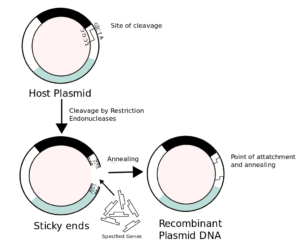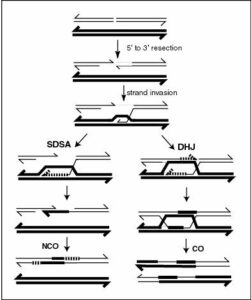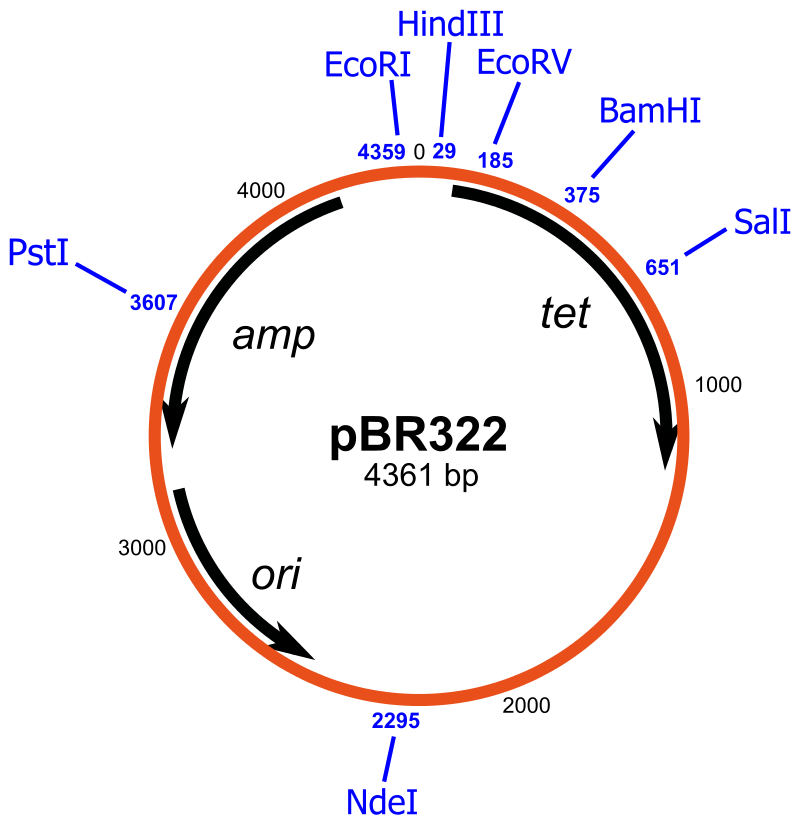There are three DNA splicing types are commonly seen in genetic and biotechnology labs. They are:
Here we will discuss the above-mentioned DNA splicing types in detail.
RECOMBINANT DNA:
Recombinant DNA is the process of genetically modifying DNA molecules by cutting and pasting different fragments that produced desired features.
rDNA or recombinant DNA is a process that uses enzymes to cut and paste DNA sequences of interest.
The recombined DNA sequences can then be placed into vectors that carry the DNA to a suitable host cell for replication or expression.
Splicing genes from one species and transferring them into the cells of a different creature or species such that the DNA gets duplicated and forms part of the organism’s genetic make-up. Restriction enzymes cleave them, and ligases connect them.

Image: Wikipedia
To create recombinant DNA, scientists must first isolate the DNA they intend to combine. DNA can be obtained from a variety of sources, including bacteria, plants, animals, algae, and fungus. Scientists use sophisticated laboratory procedures to cut the sections of DNA they desire and paste them together to create recombinant DNA or rDNA. They insert the new rDNA into a host cell, which will absorb and duplicate it, displaying the features for which it codes.
GENE SPLICING:
Genes are DNA segments that contain protein-coding instructions. Gene splicing is a type of genetic engineering that involves inserting certain genes or gene sequences into the genome of another creature. Splicing of genes is a process that takes place during the processing of deoxyribonucleic acid (DNA) to prepare it for translation into protein.
A single gene may code for numerous proteins thanks to gene splicing, a post-transcriptional alteration. In eukaryotes, gene splicing is accomplished by the differential inclusion or removal of pre-mRNA sequences before mRNA translation. Splicing of genes is a major source of protein variation.

Image: Wikipedia
During a normal gene-splicing event, pre-mRNA from one gene might result in several mature mRNA
molecules, each of which can produce multiple functional proteins. As a result, gene splicing allows a single gene to enhance its coding capacity, permitting the production of physically and functionally different protein isoforms. Splicing of genes is seen in a large number of genes. Alternative splicing is known to occur in roughly 40-60% of genes in human cells.
MICROINJECTION:
Microinjection is a method of delivering genetic material into a nucleus that is very reliable and reproducible. The method of injecting genetic elements into a live cell using glass micropipettes or metal microinjection needles is known as microinjection. Glass micropipettes come in a variety of sizes, with tip diameters ranging from 0.1 to ten millimetres. DNA or RNA is directly injected into the nucleus of the cell.
Large frog eggs, mammalian cells, mammalian embryos, plants, and tissues have all been successfully microinjected. Microinjection has traditionally been costly, time-consuming, and labour-intensive, but new technologies are making it more dependable, repeatable, and economical.
What is DNA splicing?
DNA splicing is the process by which the DNA sequence is altered by removing or adding part of its sequence.
Splicing is the process of removing unwanted parts and rejoining the necessary fragments to form a complete biomolecule chain. DNA splicing is when the DNA sequence and not the transcripted mRNA undergoes these changes.
DNA splicing is not something that occurs naturally. Rather it is a lab-produced endeavour to produce genetic modifications. Since the recombinant DNA revolution in the 1970s, splicing human DNA with non-human genetic material has been a common practice.

Image: Wikipedia
Human DNA has also been engineered in living animals, either for fundamental study or, more recently, to create enormous quantities of proteins for medical purposes.
There are 3 types of DNA splicing done in the laboratory. These include- Recombinant DNA, Gene splicing and microinjections.
DNA splicing in prokaryotes:
- The process of splicing does not occur naturally in prokaryotic cells as their RNA is devoid of introns.
- So transcription in prokaryotes produces processed mRNA. A different type of splicing can be seen in the extrachromosomal or plasmid DNA of prokaryotes which is circular.
- The prokaryotic chromosome is made up of DNA and holds all of the information required for a bacterial cell to operate normally.
- In addition to the chromosome, bacteria can carry plasmids, which are tiny rings of DNA that contain genes.
- Plasmids can splice themselves to add antibiotic-resistant genes if the organism is in an environment induced with antibiotics.
- The gene is not present in the prokaryote naturally but is spliced into the plasmid DNA in times of requirement.
- Scientists have used this method to splice more than one single antibiotic-resistant gene into the same organism and then removed it from the organism to clone it.

Image: Wikipedia
Also Read:
- Genetic diversity examples
- Algae example
- Alpha helix structure of protein
- When does the cytoplasm divide
- Do eukaryotic cells have lysosomes
- Hexapoda characteristics
- Glycosidic bond
- Active transport examples
- Bacterial cell type
- Where does bacteria live

I am Trisha Dey, a postgraduate in Bioinformatics. I pursued my graduate degree in Biochemistry. I love reading .I also have a passion for learning new languages.
Let’s connect through linked in: